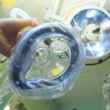Minimalist transcatheter aortic valve replacement (TAVR) is a strategy that is here to stay. We have previously published papers comparing local vs. general anesthesia, use of transthoracic vs. transesophageal echocardiography, and early discharge in TAVR. In all these papers, the “minimalist approach” included percutaneous closure of vascular access. However, few papers compare closure devices in...
NT-proBNP Level Predicts Who May Benefit From TAVR
A normal or (on the other end) a very high level of NT-proBNP should make us look for a cause other than aortic stenosis. If aortic stenosis is not the culprit of the clinical case, a transcatheter aortic valve replacement (TAVR) will hardly benefit these patients. These data come from a recently published paper in...
AHA 2020 | Post-TAVR Anticoagulation in Patients with Atrial Fibrillation
Direct anticoagulant agents were associated with lower long-term mortality in patients with atrial fibrillation discharged after successful transcatheter aortic valve replacement (TAVR) compared with classic vitamin K inhibitors. Optimal anticoagulation in patients with atrial fibrillation (AF) undergoing TAVR is unclear. We are actually just starting to know what the ideal antiplatelet therapy is for patients undergoing...
AHA 2020 | Rise in Early Discharge After TAVR Has the Expected Cost
As hospitalization time after a transcatheter aortic valve replacement (TAVR) is reduced, we are observing a concomitant increase in re-hospitalizations due to conduction disorders. Early discharge is a great step, but it should be noted that conduction disorders can happen beyond 48 hours. A few years ago, pacemaker implantation rates after discharge were about 7%;...
Conscious Versus General Anesthesia in TAVR
Patients with severe aortic stenosis undergoing transcatheter aortic valve replacement (TAVR) can safely undergo the procedure under conscious sedation. Conscious sedation has been adopted in clinical practice as a natural way of simplifying and conducting the procedure in the least invasive way possible. Currently, up to 50% of patients undergo TAVR under conscious sedation, but...
TCT 2020 | TAVR Appears to Be the Solution for All Dysfunctional Biological Valves
Transcatheter aortic valve replacement (TAVR) results durable at 5 years to treat failed surgical bioprosthetic valves and at one year to treat valves percutaneously. Regardless the type of the failed valve, the solution is TAVR. The 5 year follow up of the PARTNER 2 valve-in-valve (ViV) showed that TAVR as treatment for failed surgical bioprosthetic...
TCT 2020 | Efficacy of Cerebral Protection Device TriGUARD 3 During TAVR
Cerebral protection device TriGUARD 3, designed to cover all supra-aortic vessels during transcatheter aortic valve replacement (TAVR), is safe to use, according to the outcomes of the REFLECT II study. The technical feasibility of the device, which requires transfemoral access, does not seem to have an impact over clinical events. The primary safety endpoint was a VARC-2-defined...
Death, Stroke, and Hospitalization while Waiting for TAVR
The consequences of deferring transcatheter aortic valve replacement (TAVR) procedures because of the COVID 19 pandemic are piling up. Untreated severe aortic stenosis patients who had been scheduled for TAVR are seeing increased risk of all events, even mortality. According to recent studies published in JAMA, deferring TAVR in patients with symptomatic aortic stenosis is...
Post TAVR ASA Monotherapy Consolidates
This meta-analysis to be published in J Am Cardiol supports the use of aspirin monotherapy (ASA) after transcatheter aortic valve replacement (TAVR). The use of aspirin alone is associated to less bleeding without increased ischemic events such as strokes or mortality. The combined outcomes of four studies, including the recently published POPular TAVI (cohort A),...
Minimalist TAVR to the Max
Transcatheter aortic valve replacement (TAVR) is increasingly being performed under conscious sedation, which is associated with a multi-point benefit (including mortality). This paper, recently published in JACC Intv., shows that general anesthesia is becoming obsolete, although the magnitude the benefit derived from conscious sedation appears to be lower than in previous studies. The aim of...









